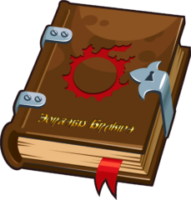From ‘Thoughts on the Primals – Malignant Divinity’ by Archon Niniri Niri
Like many primals, Ramuh is seen by his worshippers as a personification of elemental forces. Namely, Ramuh is regarded as lightning given the form and wisdom of man, a keeper of secrets and being of ultimate sagacity. Ramuh is generally thought of by his sylph petitioners as benevolent, yet the role he plays is not a gentle one and the Lord of the Levin plays the role of judge, jury and executioner over those who trespass upon or profane the deep forests that the sylphs dwell within. Ramuh is traditionally summoned at the Striking Tree, a vast tree riddled with lightning strikes and pulsing with lightning-aspected aether.
While Ramuh is a creator deity in sylphic lore, he is not considered a creator on a grand scale. Instead, the sylphs regard Ramuh as a god of man, presumably meaning the five spoken races that long dominated Eorzea. In this history the ‘men’ of the land were greedy, rash individuals who profaned and destroyed entire sections of the deep forests. Such was the destruction of these times that the very trees themselves pled their case to the gods, and were answered by a deity of men themselves; Ramuh. Ramuh cast down lightning into fruits of the forest trees, creating sylphs from their charred hulls and declaring them protectors of the forests. The sylphs regard this ancient, mythical charge as the source of their insular, vehemently defended realm deep in the Black Shroud.
This origin myth is not remotely difficult to link back to a god of the Twelve, Rhalgr. Their names are similar, their association with lightning even more so, the two gods are both frequently depicted as bearded sages and their role as saviors of groups under threat cannot be ignored either. Ramuh protected the forests by creating the sylphs and has protected the slyphs since, and Rhalgr protected refugees fleeing the Calamity of Water, guiding them to Gyr Abania where they founded Ala Mhigo.
The Lord of the Levin’s Abilities – Sylphic legend and the testimony of adventurers who faced the primal attest to two defining aspect of Ramuh’s abilities. The first is the levin-aspect of his presence. He was able to unleash ‘thundersparks and storms’ as well as ‘rolling thunder’, named for distant, constant thunder patterns in more mundane weather, though in Ramuh’s case this distance is represented by aetherically linking, or tethering, two individuals to unleash energies on both at the same time. He was also able to summon ‘lightning orbs’. The second aspect is that of his role as judge of those who trespass against the forests, and the sylphs describe his foremost ability as a ‘judgement bolt’ presumably his chosen method of execution for those who commit crimes against the woods. He is also able to summon ‘grey arbiters’ minor beings temporarily formed of his aether to assist him in battle. The name arbiter, often synonymous with judges, further underlines Ramuh’s role as a judge of natural law.
Real World Basis – Ramuh’s etymology and real life basis is complex. The influence of lighting gods such as Zeus, Jupiter, Perun and Raijin on Ramuh is obviously, especially the former three who are also sage leaders of the gods who cast lightning bolts down upon their foes. In previous games of the series he was named Indra occasionally, the Dharmic deity of thunder and lightning, a fact that sits well with the eastern influences upon Gyr Abania, further underlining the link between Ramuh and Rhalgr. His name could draw on the protective, bearded spirits of Mesopotamian faiths named the Lahmu, or Ramaa, an aspect of Vishnu and important figure in Hinduism. The Hebrew word rá’am, meaning thunder, could also provide an explanation.




Leave a Reply